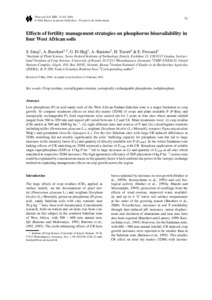Effects of fertility management strategies on phosphorus bioavailability in four West African soils
| dc.date.accessioned | 2007-03-23T11:52:01Z | |
| dc.date.available | 2007-03-23T11:52:01Z | |
| dc.date.issued | 2001 | |
| dc.identifier.issn | 0032-079X | |
| dc.identifier.uri | urn:nbn:de:hebis:34-2007032317471 | |
| dc.identifier.uri | http://hdl.handle.net/123456789/2007032317471 | |
| dc.format.extent | 586260 bytes | |
| dc.format.mimetype | application/pdf | |
| dc.language.iso | eng | |
| dc.rights | Urheberrechtlich geschützt | |
| dc.rights.uri | https://rightsstatements.org/page/InC/1.0/ | |
| dc.subject | Crop residues | eng |
| dc.subject | cereal/legume rotation | eng |
| dc.subject | isotopically exchangeable phosphorus | eng |
| dc.subject | rockphosphate | eng |
| dc.subject.ddc | 630 | |
| dc.title | Effects of fertility management strategies on phosphorus bioavailability in four West African soils | eng |
| dc.type | Aufsatz | |
| dcterms.abstract | Low phosphorus (P) in acid sandy soils of the West African Sudano-Sahelian zone is a major limitation to crop growth. To compare treatment effects on total dry matter (TDM) of crops and plant available P (P-Bray and isotopically exchangeable P), field experiments were carried out for 2 years at four sites where annual rainfall ranged from 560 to 850 mm and topsoil pH varied between 4.2 and 5.6. Main treatments were: (i) crop residue (CR) mulch at 500 and 2000 kg ha^-1, (ii) eight different rates and sources of P and (iii) cereal/legume rotations including millet (Pennisetum glaucum L.), sorhum [Sorghum bicolor (L.) Moench], cowpea (Vigna unguiculata Walp.) and groundnut (Arachis hypogaea L.). For the two Sahelian sites with large CR-induced differences in TDM, mulching did not modify significantly the soils' buffering capacity for phosphate ions but led to large increases in the intensity factor (C_p) and quantity of directly available soil P (E_1min). In the wetter Sudanian zone lacking effects of CR mulching on TDM mirrored a decline of E_1min with CR. Broadcast application of soluble single superphosphate (SSP) at 13 kg P ha^-1 led to large increases in C_p and quantity of E_1min at all sites which translated in respective TDM increases. The high agronomic efficiency of SSP placement (4 kg P ha^-1) across sites could be explained by consistent increases in the quantity factor which confirms the power of the isotopic exchange method in explaining management effects on crop growth across the region. | eng |
| dcterms.accessRights | open access | |
| dcterms.bibliographicCitation | In: Plant and Soil. Dordrecht : Kluwer. 233.2001, H. 1, S. 71-83 | |
| dcterms.creator | Sinaj, S. | |
| dcterms.creator | Bürkert, Andreas | |
| dcterms.creator | El-Hajj, G. | |
| dcterms.creator | Bationo, A. | |
| dcterms.creator | Traoré, H. | |
| dcterms.creator | Frossard, E. | |
| dc.description.everything | The original publication is available at www.springerlink.com | eng |
| dc.subject.swd | Westafrika | ger |
| dc.subject.swd | Ernterückstand | ger |
| dc.subject.swd | Getreide | ger |
| dc.subject.swd | Fruchtfolge | ger |
| dc.subject.swd | Hülsenfrüchtler | ger |
| dc.subject.swd | Stickstoffdüngung | ger |
Dateien zu dieser Ressource
Das Dokument erscheint in:
-
Publikationen [36]

